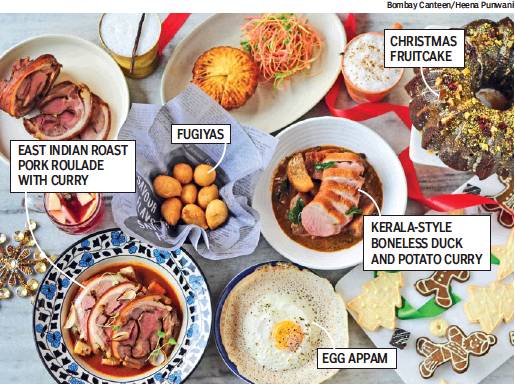Christmas cuisine: India
This is a collection of articles archived for the excellence of their content. |
Variety offered
Sonam Joshi, How India gives Xmas a delicious desi twist, December 24, 2017: The Times of India

From: Sonam Joshi, How India gives Xmas a delicious desi twist, December 24, 2017: The Times of India
From pork sorpotel to Mangalurean rice laddoos, traditional Christmas foods show that the country has made the festival its own
Though he now heads one of the country’s best restaurants, Thomas Zacharias of Bombay Canteen still associates Christmas with his grandmother’s lavish feasts in Kochi. Christmas would begin with his extended family gathering around the tree to open presents and sip homemade fruit wine. There’d be a table groaning with dishes: duck curry cooked in vinegar, potatoes and coconut milk, pork roast, a fried ‘chicken roast’, koorka ularthiyathu (Chinese potatoes and peanuts), pomfret in coconut milk, red rice, appams, and plum cake. “That’s how I was inspired to become a chef. I saw how my family was so happy through food,” Zacharias says.
In homes across India, communities celebrate Christmas in their own ways, their dining tables a medley of regional and international culinary traditions. “Many influences — Dutch, Portuguese, British, Arabic and perhaps even Chinese — have shaped the Syrian Christian Christmas in Kerala,” says Lathika George, author of The Suriani Kitchen.
Now, several restaurants and home chefs are referencing their own family recipes for inspiration to serve up feasts. “Nobody was celebrating or showcasing Indian Christmases,” Zacharias says. So this year, Bombay Canteen has a special menu that includes dishes from Nagaland, Goa, Mumbai’s East Indians and Kerala’s Syrian-Christians, with Zacharias’ grandmother’s duck curry being one of the highlights. Its sister restaurant O Pedro is focusing on festive Goan food such as shrimp pilaf with prawn wafers and pork roulade with roast potatoes. “They are rich, indulgent, celebratory dishes connected to local flavours and ingredients,” says Zacharias.
While plum cake has become synonymous with Christmas in India, it shares the spotlight with many local sweets such as crunchy kulkuls, cashew-based marzipan, guava cheese, rose cookies and neurios stuffed with coconut. A Mangalurean Christmas isn’t complete without rice laddoos flavoured with coconut, jaggery and cardamom powder. Mangaluru-based home chef Maya Pereira, who is hosting Christmas meals in Mumbai in partnership with home dining platform Authenticook, has put the laddoos on her menu along with the community’s distinctive dishes like pork bafat and indad.
Different versions of kuswar (a platter of festive sweets sent and offered to guests, relatives, neighbours and friends) are popular among Goans, East Indians and Mangalurean Catholics. The practice of exchanging kuswar continues, though many prefer ordering to making it at home. Mumbai resident Laurabelle D’Souza, who has been making traditional East Indian desserts such as milk cream, date rolls and thali sweets for the last 25 years, says she has seen a steady increase in the demand for kuswar. “I have people ordering through the year, sometimes even for Diwali,” she says.
While the rest of the world talks turkey, there is no Goan Christmas without pork, says food blogger Hilda Mascarenhas. Her Christmas lunch comprises either pork sorpotel that has been matured for a month, or vindaloo, accompanied by a spongy, fermented rice bread known as sannas, prawn pulao, chicken cafreal, stuffed pomfret or mackerel with recheado masala, beef or chicken roulade, and an array of cutlets.
In Mumbai, the roast suckling pig stuffed with chorizo, bread, vegetables and liver occupies pride of place at the tables of the Catholic East Indian community. While the East Indians share dishes like vindaloo with the Goans, there are subtle differences, like the use of bottle masala, a blend of nearly 30 spices. “It all boils down to which grandmother is cooking. The recipes may be the same but the pantry differs,” Gresham Fernandes, culinary director at the Impresario group, says. “The Goans have a clear Portuguese background. The East Indians have both an English and a Portuguese background.” Fernandes is working on a menu that showcases his heritage and the foods he’s grown up eating.
In Nagaland, each tribe has its own delicacies but a common feature is pork barbecue or a pork curry cooked with fresh bamboo shoots, kidney beans, fermented soybean-based akhuni or yambased anishi. Chubamanen Longkumer, owner of Delhi’s Nagaland Kitchen, says he stuffs fish, meat and rice in bamboo vessels and steams them over a fire, a time-consuming process reserved for Christmas. Longkumer will have specialties such as a Naga rice soup and a dry bamboo shoot salad on his Christmas menu. “When I was growing up in Dimapur, after attending church on Christmas Eve, we’d sit around the bonfire and sing,” Longkumer says. “Now, the one thing that hasn’t changed is family time.”